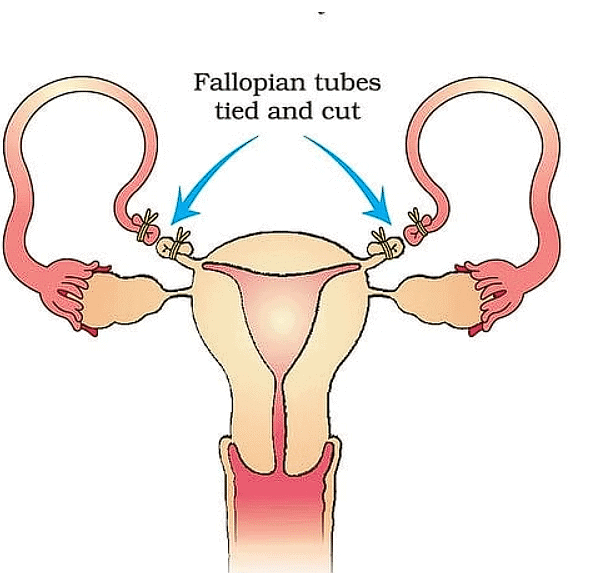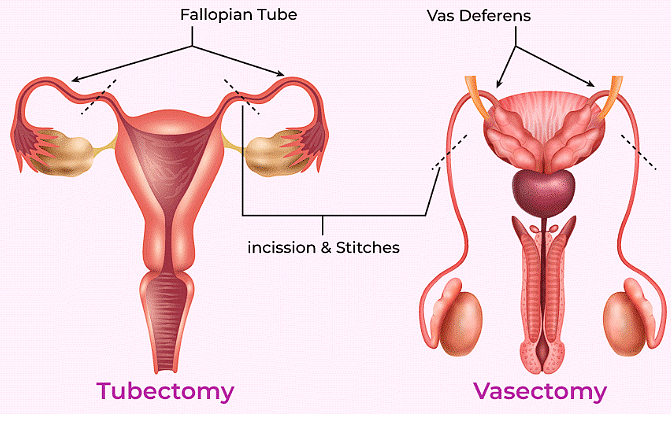Important Diagrams: Reproductive Health | Biology Class 12 - NEET PDF Download
| Table of contents |

|
| Surgical Methods of Birth Control |

|
| (a) Vasectomy |

|
| (b) Tubectomy |

|
| (c) Intrauterine Device- copper T |

|
| Diagram Based Questions- NEET |

|
Diagrams in Reproductive health bring clarity to methods of improving reproductive health helping NEET aspirants understand significance of different methods and their functions. some of the important diagrams from this chapter are given below:

Surgical Methods of Birth Control
Surgical methods are medical procedures where doctors use tools to make cuts in the body to fix a problem or reach a certain goal. In family planning, these methods are used to make someone unable to have children anymore by stopping pregnancy forever.
(a) Vasectomy
Vasectomy is a surgical procedure for male sterilization, where a small portion of the vas deferens, the tube that carries sperm from the testicles to the urethra, is either removed or tied off to prevent the passage of sperm.
This procedure is typically performed through a small incision in the scrotum. By blocking the vas deferens, sperm cannot mix with semen ejaculated from the penis, effectively preventing conception. Vasectomy is considered a permanent form of contraception, although it is sometimes possible to reverse it through a more complicated surgical procedure called vasectomy reversal.
 Vasectomy
Vasectomy
(b) Tubectomy
Tubectomy, also known as tubal ligation or female sterilization, is a surgical procedure for female contraception. In tubectomy, a small portion of the fallopian tubes, the tubes that transport eggs from the ovaries to the uterus, is either removed or tied off to prevent the eggs from reaching the uterus.This procedure can be performed through a small incision in the abdomen or vagina. By blocking the fallopian tubes, sperm cannot fertilize an egg, thus preventing conception. Tubectomy is considered a permanent form of contraception, and reversal is more difficult and less successful compared to vasectomy reversal.
 Tubectomy
Tubectomy
(c) Intrauterine Device- copper T
The copper-T intrauterine device (IUD) is a small, T-shaped device inserted into a woman's uterus for long-term contraception. It works by releasing copper ions, which are toxic to sperm, preventing fertilization.
Additionally, it causes changes in the uterine lining, making it difficult for a fertilized egg to implant. The copper-T IUD is a highly effective form of birth control, with a lifespan of up to 10 years. It does not contain hormones, making it suitable for women who cannot use hormonal contraceptives.

Diagram Based Questions- NEET
Q1: Match List I with List II. [NEET 2023]

Choose the correct answer from the options given below:
(a) A-III, B-I, C-IV, D-II
(b) A-III, B-IV, C-II, D-I
(c) A-II, B-III, C-I, D-IV
(d) A-IV, B-II, C-I, D-III
Ans. (b)
- Vasectomy is a surgical method of contraception for males. It involves cutting the vas deferens, the tubes that carry sperm from the testicles to the urethra. Vasectomy is a permanent form of contraception and is intended to be irreversible.
- Coitus interruptus, often referred to as the "withdrawal method" is a natural method of contraception. It involves withdrawing the penis from the vagina before ejaculation during sexual intercourse.
- Cervical cap is a barrier method of contraception designed for females. It is a small, thimble-shaped cap made of soft silicone or latex that fits over the cervix, blocking the entrance to the uterus.
- Saheli is an oral method of contraception in the form of a non-steroidal pill. Unlike traditional birth control pills, Saheli is a non-hormonal contraceptive pill it inhibits ovulation and altering the cervical mucus.
Q2: Which of the following is hormone-releasing IUD? [NEET 2021]
(a) LNG-20
(b) Multiload-375
(c) Lippes loop
(d) Cu-7
Ans. (a)
An effective and popular contraceptive method is the use of Intra Uterine Devices (IUDs). These Intra Uterine Devices are presently available as the non-medicated IUDs (e.g., Lippes loop), copper releasing IUDs (CuT, Cu7, Multiload 375) and the hormone releasing IUDs (Progestasert, LNG-20).
Hormonal IUDs release a small amount of progestin to prevent ovulation, thicken cervical mucus, and thin the uterine lining, making it difficult for sperm to reach the egg and for a fertilized egg to implant in the uterus.
|
59 videos|290 docs|168 tests
|

















